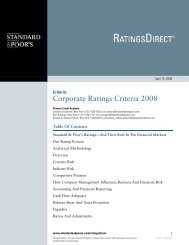European Infrastructure Finance Yearbook - Investing In Bonds ...
European Infrastructure Finance Yearbook - Investing In Bonds ...
European Infrastructure Finance Yearbook - Investing In Bonds ...
Create successful ePaper yourself
Turn your PDF publications into a flip-book with our unique Google optimized e-Paper software.
UTILITIES<br />
28 ■ NOVEMBER 2007<br />
pressure on market prices. However, new plants<br />
can’t be built quickly, so it will take some time to<br />
ease this capacity constraint.<br />
Higher profitability from increased power prices<br />
will underpin generators’ business profile<br />
As seen in Western Europe, moving from<br />
regulated cost-plus regimes to a deregulated spot<br />
electricity market typically increases generators’<br />
business risk and can often dilute credit quality.<br />
Standard & Poor’s believes that the new path to<br />
deregulation might support improved credit<br />
quality in the sector through higher transparency<br />
and price growth, while capacity payments and<br />
hedging will smooth the impact of volatile<br />
spot prices.<br />
The deregulated market will translate rising gas<br />
prices into higher electricity prices, reflecting the<br />
costs of the least efficient (marginal) gas-fired<br />
generators for all market players.<br />
Generators using other fuels such as coal,<br />
nuclear, hydropower would consequently reap<br />
higher margins, as would more efficient<br />
gas-fired producers.<br />
We expect the higher profitability to mitigate<br />
increased price volatility because stronger margins<br />
will cushion the impact on cash flow. This will<br />
somewhat offset price deregulation’s negative<br />
impact on cash flow stability. Generation<br />
companies’ profitability is currently low, with an<br />
average 10% EBITDA margin for UES and a tiny<br />
1%-2% for some thermal generators. Despite<br />
most electricity being sold at regulated tariffs,<br />
relatively small changes in price or fuel costs-together<br />
with weak margins--result in substantial<br />
cash flow fluctuation. That implies high<br />
business risk.<br />
Political risk remains key to power price<br />
deregulation and growth<br />
Political risk, however, overshadows the rosy<br />
prospects for power generators in the new market<br />
deregulation plan. Customers will bear substantial<br />
price increases and could face soaring electricity<br />
bills in the next three to four years, potentially<br />
leading to a political backlash. <strong>In</strong> addition, most<br />
of the market deregulation and corresponding<br />
price increases are scheduled for 2009-2010. But<br />
this comes after the 2008 presidential elections,<br />
when Russia will have a new president who may<br />
have different views on electricity price policy and<br />
perhaps even on the sector’s overall strategy.<br />
STANDARD & POOR’S EUROPEAN INFRASTRUCTURE FINANCE YEARBOOK<br />
Generators’ active hedging strategies could<br />
provide further cash flow stability<br />
After the wholesale market is fully deregulated,<br />
each generator’s decision on how to balance<br />
potentially profitable but volatile opportunities<br />
from spot sales in order to lock in a more certain<br />
level of profits will determine its spot-market<br />
exposure. More forward electricity sales at a fixed<br />
price that allows the generator to earn sufficient<br />
profits to support its credit quality (assuming that<br />
generation costs are also fixed) would imply a<br />
lower business risk. Generators currently can<br />
hedge price volatility through nonregulated<br />
forward contracts at a fixed price. Power<br />
exchanges plan to introduce other instruments,<br />
such as power futures, to expand hedging<br />
opportunities. Thus, a conservative hedging<br />
strategy would limit the impact of changes in spot<br />
prices on cash flow volatility in the coming one to<br />
two years.<br />
How capacity market contracts could help<br />
The proposed capacity market, a system of<br />
payments to generators that cover fixed costs, will<br />
also mitigate the impact of spot price volatility on<br />
cash flow stability.<br />
Standard & Poor’s believes that recovering<br />
fixed costs through the capacity market will<br />
underpin generation companies’ credit quality.<br />
Capacity payments, now accounting for about<br />
one-half of wholesale generation revenues,<br />
substantially reduce the operational ‘gearing’ (the<br />
level of fixed operating costs that determines the<br />
dependence of operating income variability on<br />
sales variability) of generators. These payments<br />
aren’t common in other <strong>European</strong> generation<br />
markets. The still-to-be-determined capacity<br />
pricing mechanism will heavily influence the level<br />
of market-based capacity payments and<br />
generators’ profitability and cash flow. The final<br />
mechanism expected in 2007-2008 will reduce<br />
this uncertainty.<br />
Who will benefit from market deregulation?<br />
The competitiveness and profitability of gencos in<br />
the deregulated market depend heavily on their<br />
marginal cost position. The main factor for<br />
gencos is fuel costs and for hydro generators,<br />
water tax charges.<br />
Deregulation of the electricity market will result<br />
in a gradual transition of the average electricity<br />
price from regulated tariffs that reflect costs to a



